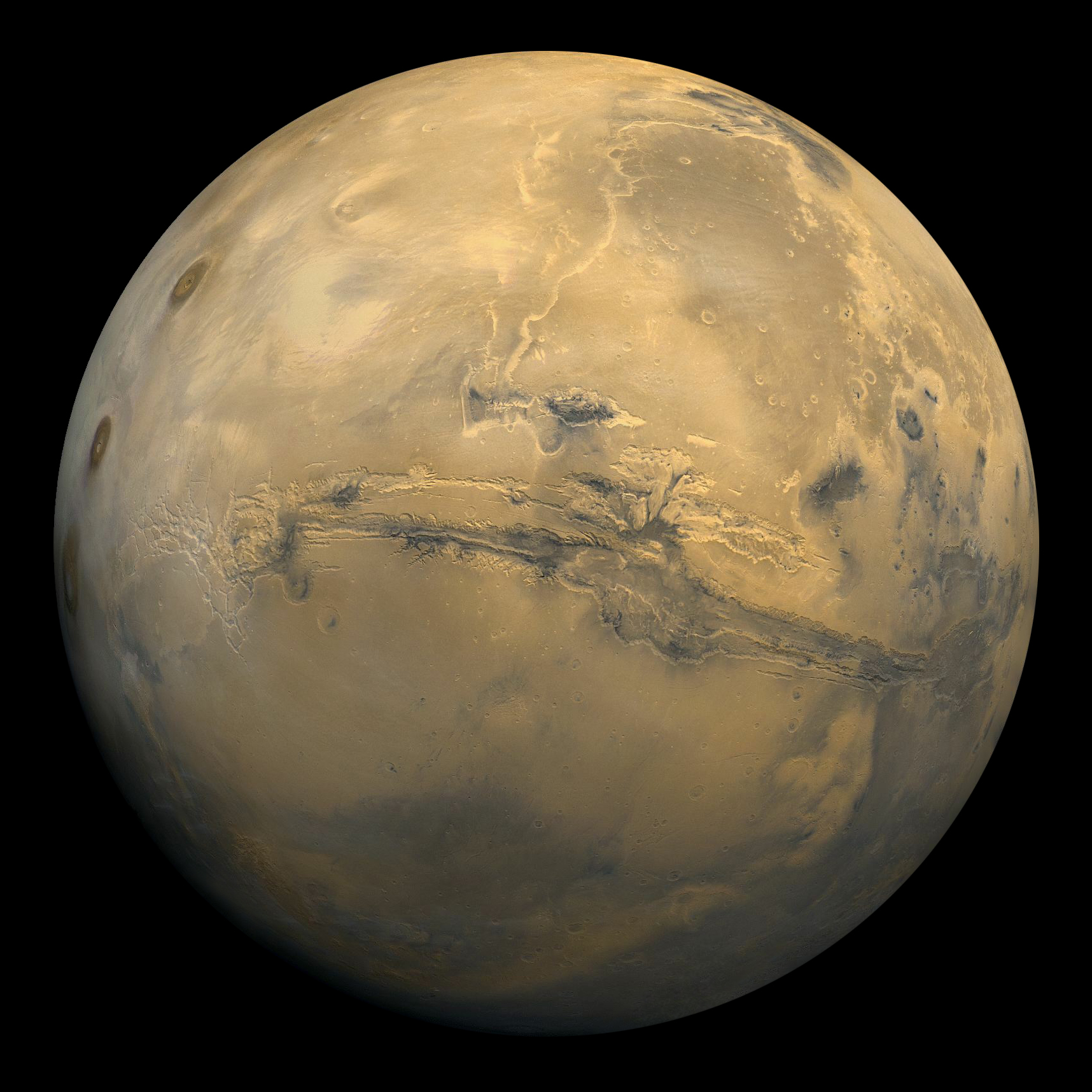
A beautiful view of Mars, from Wikipedia and NASA
“What would the wingspan of a glider on Mars be?”
Flying on Mars is tricky. I know, I’ve done it. Well, that is to say, I’ve done it in a simulator. Because a flight simulator is nothing but a giant physics engine with a bunch of mathematical constants plugged in, its possible to have the simulator spit out the atmospheric conditions of almost anywhere, and then re-create it. X-Plane, by Laminar Research is perhaps the best such flight sim available on the commercial market, and using some NASA atmospheric and geographical data, allows you to recreate flying on Mars in a pretty believable way.
Wings (airfoils) only work when the air current flows over them at a certain speed. That speed is dependent on the airfoil shape, and is subject to a lot of heavy math well above my humble head to try and figure out. If the speed of the flow over the airfoil gets too low, it stops generating lift. This is called a stall, and is generally bad news for whatever the airfoil is attached to, that is: the rest of the plane with you in it. So a certain speed needs to be maintained in order to stay in the air. With a powered airplane, the engine provides that forward speed. In a Helicopter, the rotation of the blades provides the lift, and in a glider it is gravity pulling the plane downwards that provides the lift. Let’s throw a theoretical number out there. Imagine that Glider X needed to maintain a minimum speed of 20 miles per hour in order to stay airborne.
Air density on Mars being 1% that of earth. Indicated airspeed (the air density that the airfoil is seeing) is proportional to the square root of the actual air density, so the real air speed is roughly 10 times that indicated. So if Glider X was on Mars, it would require a minimum airspeed of 200 miles per hour at all times to stay airborne!

A glider on Mars would look a lot like a Glider on Earth. From Wikipedia user DG Flugzeugbau
Of course, with the air density being so low, things like turning and landing become incredibly tricky propositions. Take it from me after a few test flights on Mars: Nothing happens in a hurry in the air over the red planet. Turns have to be thought of well in advance, and approached deliberately. Landing is a scary prospect. Approaching the ground at over 600 miles per hour, and then bouncing along the country side for miles because the gravity is only 1/3 that of earth, and you only carry 1/3 the weight, for 3/3 of the inertia.
So how big would a glider be on mars? I’d say roughly the same size as one on Earth. So a glider meant to carry 1-2 people, plus all their gear? Let’s add a bit of size for survival equipment, communications, and oxygen, and let’s ballpark a wingspan at around 70-100 feet. The fuselage would be around 25-30 feet long would weigh (on earth mind you) around 1500-1750 pounds.
Getting the thing into the sky would require one crazy tow plane, but that’s a topic for another post. But I leave you with this thought….Imagine being towed along the ground in your 1500 pound glider, with nothing but a spacesuit to protect you as your rocket powered tow plane accelerates to 600 miles an hours in order to generate enough lift to pull you into the sky (remember the wing only sees 1/10 of that airflow).

A Theoretical flight over Mars, powered by X Plane. By Austin Meyer.
Of course, there are other ways to launch a glider… using a winch on the ground to pull it into the air works, but imagine needing miles of tow rope pulling at a few hundred miles an hour, and you see the problems here. Of course the glider could carry its own engine into the sky, shutting it off in the sky and coasting. I Imagine this would use a small rocket motor, and the plane would look something like a U2 Spyplane, only without the intakes.
“Would a windmill work on Mars?”

Rønland Windpart, Denmark. From Wikipedia user Fanny Schertzer
In short, yes. As discussed above, windmills are nothing but airfoils. Given enough wind speed, a windmill would work. Now the problem comes in at finding enough wind on Mars. Where do we find enough wind? Without getting into a long essay on atmospheric conditions and high and low pressure zones, I’ll be brief.
Temperatures rising and falling cause shifts in air pressure. Air pressure causes winds to start flowing. Due to the axial tilt of Mars being less than that of the Earth, there is less temperature variance between seasons. This forces the majority of the weather systems to occur around the polar regions, which still have seasonal deposits of Ice that grow and recede annually.
So would a windmill work on Mars? Sure. But it’d have to be three times as big (due to lack of air density) to spin at the same speed. Of course, it would be easier to build massive structures on mars due to the lower gravity. With temperature variances being up to 100 degrees Kelvin at the poles, and the average wind speed on Mars being about 20 mph, you’d have a chance of having higher speeds near the poles, which would be where I’d put my Windmills.
I’d like to thank Barb Leflar Jackson (follow her on twitter at @bleflarjackson) for this episode’s very interesting questions. It doesn’t take much to get me back to the Red Planet, and these questions were fun to think about and answer!
Send more of your questions to , or on twitter @The_Clock_Doc.

Pingback: (Epic) Episode 35: Future Weapons | Geekloo
Pingback: CHSR-FM 97.9 | (Epic) Episode 35: Future Weapons(Epic) Episode 35: Future Weapons - CHSR-FM 97.9